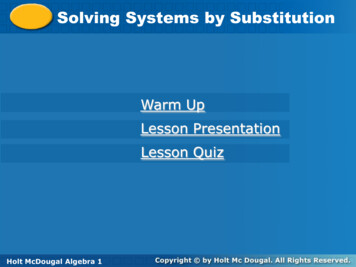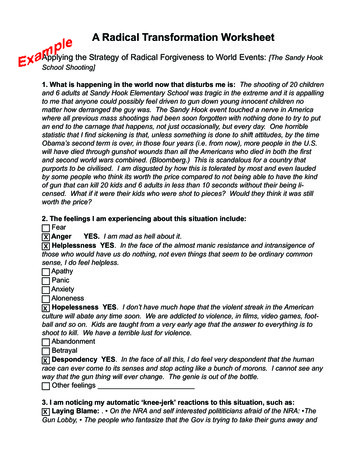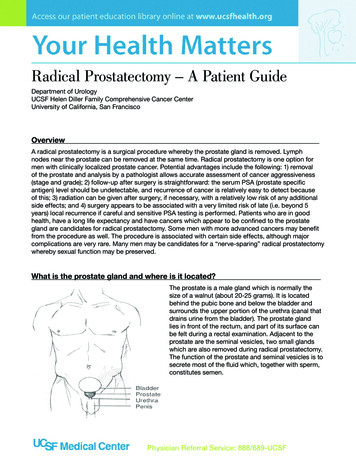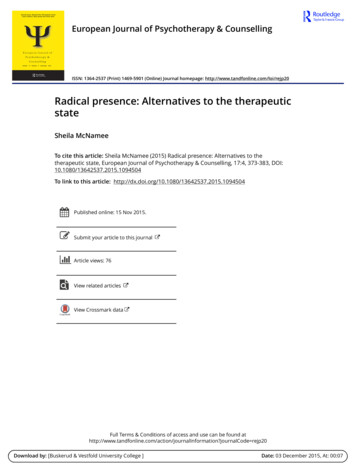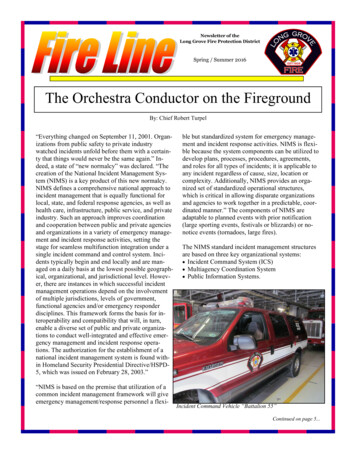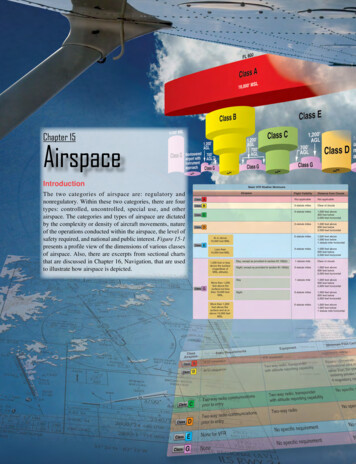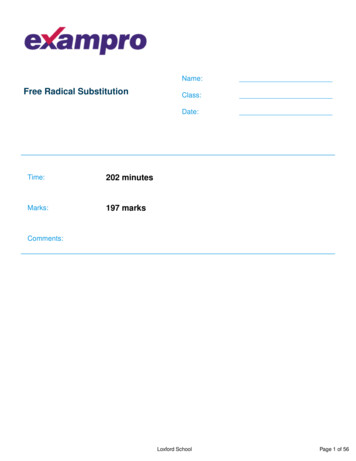
Transcription
Free Radical SubstitutionTime:202 minutesMarks:197 marksName:Class:Date:Comments:Loxford SchoolPage 1 of 56
1.Refrigerants are substances used to cool refrigerators and freezers. Until recently, many of thecompounds used as refrigerants were chlorofluorocarbons (CFCs), but these are now known toform chlorine radicals. CFCs have been phased out in many countries by internationalagreement.(a)Write two equations to show how chlorine radicals react with ozone molecules in theupper atmosphere.1.2.(2)(b)Chloropentafluoroethane is a CFC that has been used as a refrigerant.Draw its displayed formula.(1)(c)1,1,1-trifluoroethane (CF3CH3) is one of the molecules that has been used as arefrigerant in place of CFCs.Explain why 1,1,1-trifluoroethane does not lead to the depletion of the ozone in the upperatmosphere.(1)Loxford SchoolPage 2 of 56
(d)One of the steps in the synthesis of 1,1,1-trifluoroethane (CF3CH3) is the reaction of1,1-difluoroethane (CHF2CH3) with fluorine in a free-radical substitution reaction.Write two equations to represent the propagation steps in this conversion of CHF2CH3 intoCF3CH3Propagation step 1Propagation step 2(2)(e)A refrigerator contains 1.41 kg of 1,1,1-trifluoroethane (CF3CH3).Calculate the number of molecules of 1,1,1-trifluoroethane in the refrigerator.Give your answer to an appropriate number of significant figures.(The Avogadro constant L 6.022 1023 mol 1)(2)(f)There are growing concerns about the use of 1,1,1-trifluoroethane as a refrigerant asit is a greenhouse gas that absorbs some of Earth’s infrared radiation.Give one reason why bonds in molecules such as carbon dioxide and 1,1,1-trifluoroethaneabsorb infrared radiation.(1)(Total 9 marks)Loxford SchoolPage 3 of 56
2.There are many uses of halogenated organic compounds despite environmental concerns.(a)Bromotrifluoromethane is used in fire extinguishers in aircraft.Bromotrifluoromethane is formed when trifluoromethane reacts with bromine.CHF3 Br2CBrF3 HBrThe reaction is a free-radical substitution reaction similar to the reaction of methane withchlorine.(i)Write an equation for each of the following steps in the mechanism for the reaction ofCHF3 with Br2Initiation stepFirst propagation stepSecond propagation stepA termination step(4)(ii)State one condition necessary for the initiation of this reaction.(1)(b)Bromine-containing and chlorine-containing organic compounds may have a role in thedecomposition of ozone in the upper atmosphere.(i)Draw an appropriate displayed formula in the space provided to complete thefollowing equation to show how CBrF3 may produce bromine atoms in the upperatmosphere. CBrF3Br (1)Loxford SchoolPage 4 of 56
(ii)In the upper atmosphere, it is more likely for CBrF3 to produce bromine atoms than itis for CClF3 to produce chlorine atoms.Suggest one reason for this.(1)(iii)Bromine atoms have a similar role to chlorine atoms in the decomposition of ozone.The overall equation for the decomposition of ozone is2O33O2Write two equations to show how bromine atoms (Br ) act as a catalyst in thedecomposition of ozone.Explain how these two decomposition equations show that bromine atoms behave asa catalyst.Equation 1Equation 2Explanation(3)(Total 10 marks)Loxford SchoolPage 5 of 56
3.Trifluoromethane (CHF3) can be used to make the refrigerant thane is formed when trifluoromethane reacts with chlorine.CHF3 Cl2CClF3 HClThe reaction is a free-radical substitution reaction similar to the reaction of methane withchlorine.(i)Write an equation for each of the following steps in the mechanism for the reaction ofCHF3 with Cl2Initiation stepFirst propagation stepSecond propagation stepTermination step to form hexafluoroethane(4)(ii)Give one essential condition for this reaction.(1)(b)In some refrigeration systems, CHF3 has replaced CClF3 because of concerns about ozonedepletion.(i)Identify the species formed from CClF3 that is responsible for the catalyticdecomposition of ozone in the upper atmosphere.(1)(ii)Write an overall equation to represent the decomposition of ozone into oxygen.(1)(Total 7 marks)Loxford SchoolPage 6 of 56
4.The refrigerant R410A, used in air conditioners, is a mixture of two fluoroalkanes,pentafluoroethane and difluoromethane.(a)(i)The mechanism for the reaction of fluorine with either an alkane or a fluoroalkane issimilar to that for the reaction of chlorine with methane.Name the type of mechanism for the reaction of chlorine with methane.(1)(ii)Write equations for the following steps in the mechanism for the reaction of fluorinewith fluoromethane (CH3F) to form difluoromethane (CH2F2).Initiation stepFirst propagation stepSecond propagation stepA termination step leading to the formation of 1,2-difluoroethane.(4)(iii)Write an overall equation for the reaction of fluorine with ethane to formpentafluoroethane (CF3CHF2) by this mechanism.(1)(b)The refrigerant R112A (CCl3CF2Cl) has been banned because of concerns about ozonedepletion.Give the IUPAC name for CCl3CF2Cl(1)Loxford SchoolPage 7 of 56
(c)Nitrogen monoxide (NO) catalyses the decomposition of ozone into oxygen.(i)Write the overall equation for this decomposition.(1)(ii)Use the overall equation to deduce Step 3 in the following mechanism that showshow nitrogen monoxide catalyses this decomposition.Step 1 O3Step 2 NO O3O O2NO2 O2Step 3(1)(Total 9 marks)5.Oxygen and ozone (O3) both occur as gases in the upper atmosphere.Chlorine atoms catalyse the decomposition of ozone and contribute to the formation of a hole inthe ozone layer.These chlorine atoms are formed from chlorofluorocarbons (CFCs) such as CF3Cl(a)(i)Give the IUPAC name of CF3Cl(1)(ii)Complete the following equation that shows the formation of a chlorine atom from amolecule of CF3Cl(1)(iii)State what the represents in Cl (1)(b)Write two equations that show how chlorine atoms catalyse the decomposition of ozoneinto oxygen.Equation 1Equation 2(2)Loxford SchoolPage 8 of 56
(c)An equilibrium is established between oxygen and ozone molecules as shown below.3O2(g)(i)2O3(g)ΔH 284 kJ mol–1State Le Chatelier’s principle.(1)(ii)Use Le Chatelier’s principle to explain how an increase in temperature causes anincrease in the equilibrium yield of ozone.(2)(d)Chemists supported the legislation to ban the use of CFCs. Modern refrigerators usepentane rather than CFCs as refrigerants.With reference to its formula, state why pentane is a more environmentally acceptablerefrigerant.(1)(Total 9 marks)Loxford SchoolPage 9 of 56
6.Chlorine can be used to make chlorinated alkanes such as dichloromethane.(a)Write an equation for each of the following steps in the mechanism for the reaction ofchloromethane (CH3Cl) with chlorine to form dichloromethane (CH2Cl2).Initiation stepFirst propagation stepSecond propagation stepThe termination step that forms a compound with empirical formula CH2Cl.(4)(b)When chlorinated alkanes enter the upper atmosphere, carbon-chlorine bonds are broken.This process produces a reactive intermediate that catalyses the decomposition of ozone.The overall equation for this decomposition is2O3(i)3O2Name the type of reactive intermediate that acts as a catalyst in this reaction.(1)(ii)Write two equations to show how this intermediate is involved as a catalyst in themdecomposition of ozone.Equation 1Equation 2(2)(Total 7 marks)Loxford SchoolPage 10 of 56
7.Haloalkanes are used as refrigerants, solvents and anaesthetics.(a)Trichloromethane (CHCl3) is a haloalkane that can be formed by heating a mixture ofchloromethane (CH3Cl) and chlorine.(i)Write an overall equation for the formation of trichloromethane by the reaction ofchloromethane with chlorine.(1)(ii)Name the mechanism for this formation of trichloromethane.(1)(iii)Dichloromethane (CH2Cl2) is an intermediate in this formation of trichloromethane.Write an equation for each of the following steps in the mechanism for the reaction ofdichloromethane with chlorine.Initiation stepFirst propagation stepSecond propagation stepA termination step leading to the formation of a compound with formula C2H2Cl4(4)Loxford SchoolPage 11 of 56
(b)Chlorotrifluoromethane (CClF3) is used as a refrigerant, but is being phased out due toconcerns about ozone depletion in the upper atmosphere.In the upper atmosphere, CClF3 decomposes in the presence of UV light forming a reactiveintermediate that catalyses the decomposition of ozone.(i)Write an equation to show how CClF3 decomposes to form the reactive intermediate.(1)(ii)Write two equations to show how this reactive intermediate is involved in catalysingthe decomposition of ozone.1.2.(2)(Total 9 marks)8.This question is about the reactions of alkanes.(a)Alkanes can be used as fuels.Give an equation for the combustion of heptane (C7H16) in an excess of oxygen.(1)(b)Heptane can be obtained from the catalytic cracking of hexadecane (C16H34) at a hightemperature.Identify a suitable catalyst for this process.Give one condition other than high temperature.Give an equation for the catalytic cracking of one molecule of hexadecane to produce onemolecule of heptane, one molecule of cyclohexane and one other product.CatalystConditionEquation(3)(c)Alkanes can be used in free-radical substitution reactions to produce halogenoalkanes.Give equations for the propagation steps in the reaction of butane to form 2-chlorobutane.(2)Loxford SchoolPage 12 of 56
(d)Chlorofluorocarbons (CFCs) are a group of halogenoalkanes currently banned in manycountries. They cannot be used as solvents or refrigerants because of their effect on theenvironment.The structure of a CFC is shown.Identify the radical produced from this CFC that is responsible for the depletion of ozone inthe atmosphere.Explain, with the aid of equations, why a single radical can cause the decomposition ofmany molecules of ozone.RadicalExplanation(4)(Total 10 marks)Loxford SchoolPage 13 of 56
9.Which equation represents a termination step?ABCD(Total 1 mark)10.Chloromethanes, such as dichloromethane and trichloromethane, are produced in industry asthey have many uses.Trichl
(d) Chlorofluorocarbons (CFCs) are a group of halogenoalkanes currently banned in many countries. They cannot be used as solvents or refrigerants because of their effect on the environment. The structure of a CFC is shown. Identify the radical produced from this CFC that is responsible for the depletion of ozone in the atmosphere.
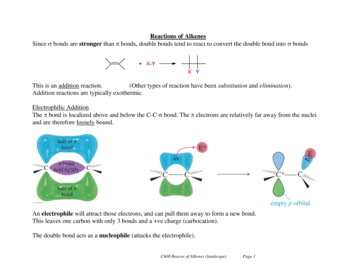

![Radical Healing Syllabus[4] - School of Social Work](/img/36/radical-healing-syllabus-2.jpg)
